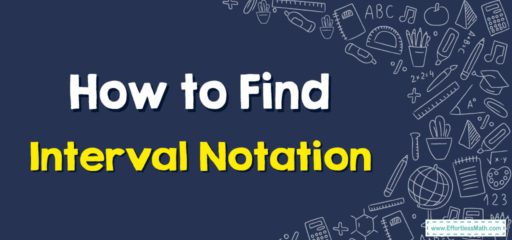How to Find Interval Notation
Interval notation provides a succinct way to describe sets of numbers, letting you quickly understand which numbers are included and excluded from a set. In this article, we will learn together how to find interval notation.

Step-by-step Guide to Find Interval Notation
Here is a step-by-step guide to finding interval notation:
Step 1: A Grasping of Boundaries: Understand the Basics.
- Endpoints: In the realm of numbers, endpoints are the alpha and omega of our interval. They’re the sentinels, defining where your interval starts and concludes.
- Types of Endpoints: Behold the distinction – the “closed” endpoint includes the value (marked as \([a]\) or \([b]\)) while the “open” endpoint excludes it (represented as \((a\) or \(b)\)).
Step 2: Dive into the Depths: Identify the Interval.
- Visual Analysis: Stare at the given number line, graph, or mathematical problem. Can you discern where the interval begins and culminates?
- Determine Continuity: Does the interval span a continuous range? Or do you encounter islands of isolated numbers?
Step 3: Enumerate the Realm: Identify the Type of Interval.
- Infinite Expanses: Does the interval stretch indefinitely? Note these infinite possibilities:
- \(∞\): The symbol that strides endlessly towards the positive spectrum.
- \(−∞\): This one drifts eternally in the negative abyss.
- Finite Confinements: Are you dealing with a limited range? Ah, that’s when both endpoints are tangible numbers.
Step 4: The Dance of Inclusivity: Determine Open or Closed Intervals.
- Gaze at the Graph: On a number line:
- A filled dot indicates the embrace of that value – a closed interval.
- An empty dot showcases exclusion, hinting at an open interval.
- In Mathematical Statements: Phrases such as “less than or equal to” beckon a closed interval. In contrast, “less than” (without equality) points towards an open interval.
Step 5: The Grand Conjunction: Unions.
- Disjointed Intervals: Sometimes, intervals can be discrete, disconnected fragments.
- The Bridging Symbol: The union symbol \(∪\) serves to connect these fragments in your notation.
Step 6: The Art of Transcription: Writing the Interval Notation.
- The Basic Syntax: The common structure is a, b, where the underlines can be either brackets \([ ]\) or \((\).
- Incorporating Infinity: For infinite intervals, replace one or both endpoints with \(∞\) or \(−∞\). Always use parentheses with infinity; it’s a concept, not a precise number.
Step 7: Proofreading the Narrative: Review Your Notation.
- Consistency: Ensure that the notation accurately reflects the interval’s nature.
- Validity: Confirm that you’ve appropriately used brackets or parentheses to indicate open or closed intervals.
Step 8: Embark on Further Journeys: Apply and Practice.
- Expand Horizons: Delve into more complex scenarios, such as absolute value inequalities.
- Practice is the Key: The universe of numbers is vast. Wander frequently to familiarize yourself with its intricacies.
By mastering this opulent and detailed procedure, you’ll be well-equipped to navigate the rich tapestry of interval notation. The more you delve into its complexities, the more rewarding your mathematical adventures will become!
Related to This Article
More math articles
- How to Line Up Decimals: The Orderly Approach to Decimal Numbers
- How to Graph Quadratic Functions? (+FREE Worksheet!)
- Unlock the Gateway to Academic Achievement: “OAR Math for Beginners” Comprehensive Solution Manual
- 3rd Grade ILEARN Math Worksheets: FREE & Printable
- Area Models Unveiled: How to Complete Decimal Division Equations
- How to Solve Linear Inequalities?
- Number Properties Puzzle – Challenge 20
- 3rd Grade Georgia Milestones Assessment System Math FREE Sample Practice Questions
- Best Calculators for Linear Algebra and Calculus
- 5th Grade IAR Math FREE Sample Practice Questions





























What people say about "How to Find Interval Notation - Effortless Math: We Help Students Learn to LOVE Mathematics"?
No one replied yet.